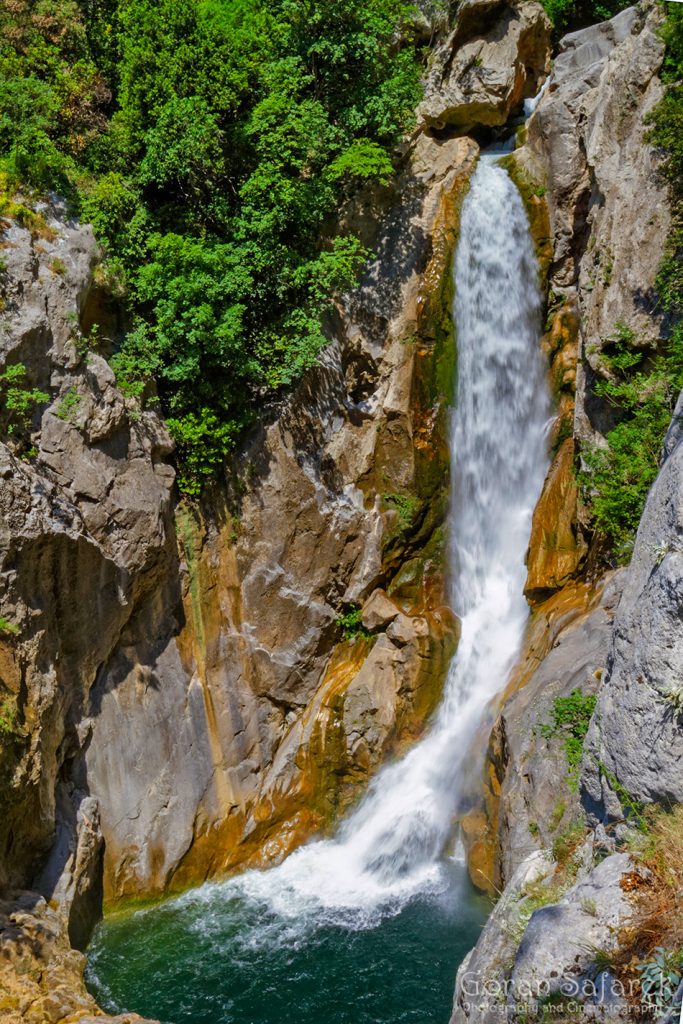Discover the highest waterfalls in Croatia—from Plitvice to Krka, explore natural wonders and find out the best time to visit!
When we think of Croatia’s natural wonders, most people picture crystal-clear Adriatic Sea, pebble beaches, and Mediterranean islands. But deep in the heart of Croatia’s forests, mountains, canyons, and rivers lie mighty waterfalls—some reaching up to 78 meters—that will leave you breathless with their power, height, and surroundings. In this guide, we uncover the highest waterfalls in Croatia—from world-famous giants to hidden cascades that are equally captivating. Lace up your hiking boots, charge your camera, and dive into this watery guide to Croatia’s scenic beauty!
1. Ilinac Waterfall – Cetina Canyon near Omiš (135 m)
One of the tallest waterfalls in Dalmatia—and also one of the most hidden. Ilinac only comes to life after heavy rains, turning into a dramatic spectacle. It’s tucked away in a wild part of the Cetina canyon above Omiš.
📍 Best time to visit: After heavy rainfall
🗺️ Access: Gravel road and hiking trail; sturdy footwear is a must
2. Veliki Slap – Plitvice Lakes National Park (78 m)
Croatia’s highest and most famous waterfall, located in Plitvice Lakes National Park. It plunges an impressive 78 meters into a turquoise lake below. In winter, it often freezes completely, turning into a stunning natural ice sculpture.
📍 Best time to visit: Spring and autumn
🗺️ Access: Easily reached via the main entrance trail in the national park
3. Zeleni Vir Waterfall – Skrad (approx. 70 m)
Zeleni Vir, together with the nearby Vražji Prolaz (Devil’s Passage), is one of the most photogenic spots in the Gorski Kotar region. The waterfall tumbles down a nearly vertical cliff into a forest oasis—ideal for a day trip.
📍 Best time to visit: Spring and summer
🗺️ Access: Maintained hiking trail; entry ticket required
4. Gubavica Waterfall – Cetina River near Zadvarje (approx. 50 m)
Near the village of Zadvarje, the Cetina River creates the impressive Gubavica waterfall, cascading from a high cliff into the canyon below. You can view it from a lookout point, and the area is also popular for rafting and canyoning.

📍 Best time to visit: Spring and autumn
🗺️ Access: Via road and walking paths
5. Skradinski Buk – Krka National Park (17 cascades, approx. 45 m total)
The widest and most visited waterfall on the Krka River, famous for its layered terraces and turquoise waters. While none of its individual drops are extremely tall, together they form a spectacular scene. Swimming was once allowed here—but is now prohibited to protect the area.
📍 Best time to visit: Spring and early autumn
🗺️ Access: By boat from Skradin or on foot from Lozovac
6. Copot Waterfall – Ćićarija, Istria (42 m)
One of the tallest waterfalls in Istria, nestled in the forested hills behind Buzet. Copot plunges down a rocky wall in the peaceful silence of untouched nature. Most impressive in early spring when water flow is strongest.
📍 Best time to visit: March to May
🗺️ Access: Forest trail from the village of Brgad
7. Skakavac Waterfall – Papuk Nature Park (35 m)
The tallest waterfall in eastern Croatia! Located in Papuk Geopark, this waterfall marks the end of an educational trail and is one of the few high falls in Slavonia.

📍 Best time to visit: Spring
🗺️ Access: Maintained trail from the town of Velika
8. Manojlovac Waterfall – Krka National Park (32 m single drop, 59.6 m total)
Though Skradinski Buk gets all the fame, Manojlovac is actually the tallest waterfall on the Krka River. It’s located near the Roman ruins of Burnum. It may dry out in summer, so the best time to visit is early spring.
📍 Best time to visit: March to May
🗺️ Access: Short walk from a lookout point, off the main tourist path
➕ Bonus: Seasonal Waterfalls for Explorers
🔹 Brisalo Waterfall on Učka – only appears after heavy rains, but when it does, it drops from over 30 meters.
🔹 Vejalnica Waterfall – a mysterious seasonal waterfall in Lika.
🔹 Sopot Waterfall near Labin – a fairytale-like Istrian cascade with a trail that passes old mills.
Tips for Visiting Waterfalls in Croatia
- Best seasons: Spring and early autumn – waterfalls are at their most powerful, and nature is in full bloom.
- Footwear: Sturdy hiking boots with good grip are essential.
- Photography gear: Bring a drone, tripod, and ND filters for silky waterfall shots.
- Respect nature: Don’t leave trash, stick to marked paths, and never enter the water unless explicitly allowed.
Final Thoughts
Croatia is full of waterfalls that can rival some of the most beautiful in the world—and the best part? Many are still off the beaten path. Whether you’re chasing adrenaline, photographic magic, or the peaceful hush of untouched nature, Croatian waterfalls offer unforgettable experiences.





